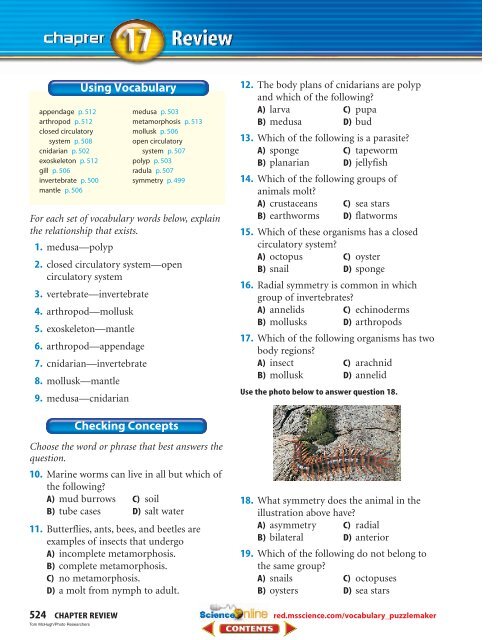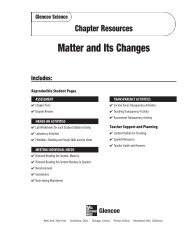Chapter 17: Invertebrate Animals
Chapter 17: Invertebrate Animals
Chapter 17: Invertebrate Animals
Create successful ePaper yourself
Turn your PDF publications into a flip-book with our unique Google optimized e-Paper software.
appendage p. 512<br />
arthropod p. 512<br />
closed circulatory<br />
system p. 508<br />
cnidarian p. 502<br />
exoskeleton p. 512<br />
gill p. 506<br />
invertebrate p. 500<br />
mantle p. 506<br />
For each set of vocabulary words below, explain<br />
the relationship that exists.<br />
1. medusa—polyp<br />
2. closed circulatory system—open<br />
circulatory system<br />
3. vertebrate—invertebrate<br />
4. arthropod—mollusk<br />
5. exoskeleton—mantle<br />
6. arthropod—appendage<br />
7. cnidarian—invertebrate<br />
8. mollusk—mantle<br />
9. medusa—cnidarian<br />
medusa p. 503<br />
metamorphosis p. 513<br />
mollusk p. 506<br />
open circulatory<br />
system p. 507<br />
polyp p. 503<br />
radula p. 507<br />
symmetry p. 499<br />
12. The body plans of cnidarians are polyp<br />
and which of the following<br />
A) larva C) pupa<br />
B) medusa D) bud<br />
13. Which of the following is a parasite<br />
A) sponge C) tapeworm<br />
B) planarian D) jellyfish<br />
14. Which of the following groups of<br />
animals molt<br />
A) crustaceans C) sea stars<br />
B) earthworms D) flatworms<br />
15. Which of these organisms has a closed<br />
circulatory system<br />
A) octopus C) oyster<br />
B) snail D) sponge<br />
16. Radial symmetry is common in which<br />
group of invertebrates<br />
A) annelids C) echinoderms<br />
B) mollusks D) arthropods<br />
<strong>17</strong>. Which of the following organisms has two<br />
body regions<br />
A) insect C) arachnid<br />
B) mollusk D) annelid<br />
Use the photo below to answer question 18.<br />
Choose the word or phrase that best answers the<br />
question.<br />
10. Marine worms can live in all but which of<br />
the following<br />
A) mud burrows C) soil<br />
B) tube cases D) salt water<br />
11. Butterflies, ants, bees, and beetles are<br />
examples of insects that undergo<br />
A) incomplete metamorphosis.<br />
B) complete metamorphosis.<br />
C) no metamorphosis.<br />
D) a molt from nymph to adult.<br />
18. What symmetry does the animal in the<br />
illustration above have<br />
A) asymmetry C) radial<br />
B) bilateral D) anterior<br />
19. Which of the following do not belong to<br />
the same group<br />
A) snails C) octopuses<br />
B) oysters D) sea stars<br />
524 CHAPTER REVIEW<br />
Tom McHugh/Photo Researchers<br />
red.msscience.com/vocabulary_puzzlemaker














